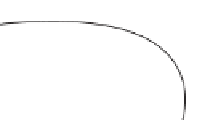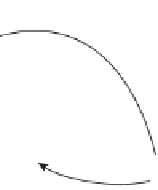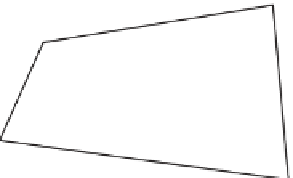Graphics Reference
In-Depth Information
M
1
q
2
q
1
2
q
1
M
2
2
q
2
Figure 11.8: We have two rotation matrices,
M
1
and
M
2
; the first corresponds to a pair of
antipodal quaternions,
±
q
1
, and the second to a different pair of antipodal quaternions,
±
q
2
)
and interpolate between them (as indicated by the thick red arc); we then can project the
interpolated points to
SO
(
3
)
to interpolate between
M
1
and
M
2
.
q
2
. Starting at
q
1
, we choose whichever of
q
2
and
−
q
2
is closer (in this case,
−
C
B
A
D
Figure 11.9: We can compute the midpoint of the quadrilateral ABCD by finding the mid-
points of AB and CD (marked by circles), and then the midpoint of the segment between
them,
or
by doing the same process to the edges AD and BC (whose midpoints are marked
by squares); the resultant quadrilateral midpoint (indicated by the diamond) is the same in
both cases. This does not happen when we work with quaternions.
With this notion of “interpolate between rotations” or “interpolate between
quaternions” in hand, other operations, like blending together three or four rota-
tions, also become possible. Indeed, even operations like the curve subdivision we
did in Chapter 4 become possible in
SO
(
3
)
instead of
R
2
. One must be careful,
however. While it's nice to be able to interpolate between quaternions in the same
way we construct a segment between points in the plane, the analogy has some
weaknesses: In the plane, we can construct points
(
1
−
t
)
A
+
tB
for
t
between 0
>
and 1, and they lie between
A
and
B
.Ifweuse
t
1, we get a point “beyond
B
.”
On the other hand, if we do spherical linear interpolation between quaternions
q
1
and
q
2
, as we increase
t
further and further, the result eventually wraps around the
sphere and returns to
q
1
.
Other “obvious” things fail as well. In the plane, we can find the center of
a quadrilateral by bisecting opposite sides and finding the midpoint of the edge
between these points. It doesn't matter which pair of opposite sides we choose—
the result is the same, as shown in Figure 11.9. But with quaternions, it's generally
not the same.
Inline Exercise 11.5:
On the 2-sphere, let
A
=
B
=(
0, 1, 0
)
,
C
=(
1, 0, 0
)
,
and
D
=(
0, 0, 1
)
. Compute (by drawing—you should not need to perform any
algebra) the center of the quadrilateral
ABCD
twice, once using each pair of
opposite sides, to verify that the results are not the same.


























